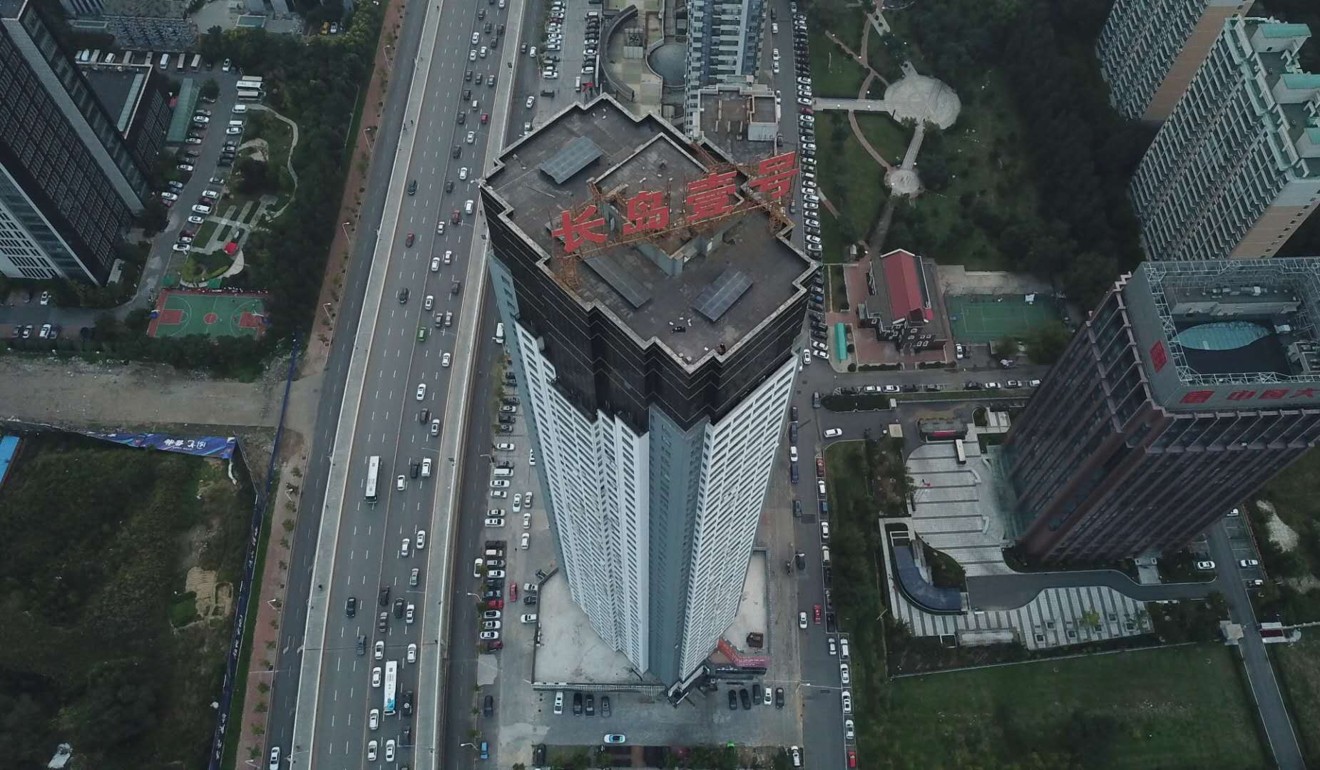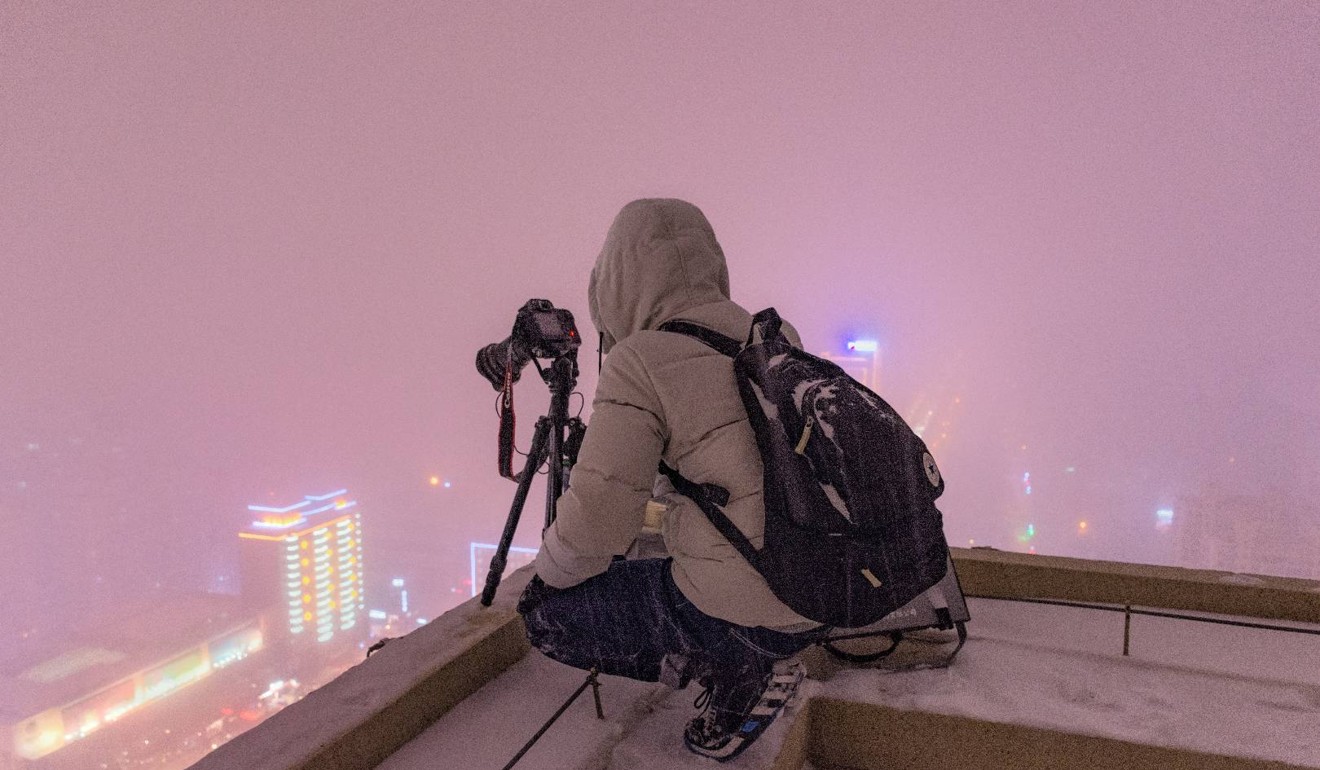
Friends in high places: why China’s extreme rooftoppers are reaching for new heights
The activity has come under scrutiny with the death of a young man last month but enthusiasts say the view from a skyscraper’s summit can change your outlook on life

When 21-year-old Tong Shenglin saw a photo taken from the top of his city’s tallest building three years ago, he knew he had to get up there and take a shot for himself.
The mesmerising skyline was snapped from the summit of the 310-metre-tall Maoye Centre in Shenyang, Liaoning province, a skyscraper then in the final stages of construction.
Armed with a hard hat and camera, he told construction workers putting the finishing touches to the building that he was a fine arts student and wanted to take a photo from the peak for a project. They let him take the lift to the 71st floor and climb the final three storeys, allowing him to finally capture the moment while sitting on the building’s edge.

The experience was dizzying but thrilling.
“The view was amazing. There was also a sense of achievement,” he said.
Since then, Tong has looked down but never looked back. He is no longer afraid of heights and has made it to the top of all of the northern Chinese city’s biggest commercial and residential buildings.
He is part of a loose but growing band of rooftoppers in China, people who reach for new heights to take a bird’s-eye view of the urban world and share it online.
That pursuit is under scrutiny with the death of Wu Yongning, a 26-year-old rooftopper who fell from a 62-storey building in central China last month while being filmed doing pull-ups untethered from the top of the skyscraper.
Chinese media reports quoted Wu’s parents as saying he was hoping to earn 100,000 yuan (US$15,000) for the footage, prompting public calls for regulation of the activity.
Other daredevils have gained attention for scaling tall buildings from the outside or doing other stunts.
But for enthusiasts like Tong, the thrill is not in the risk but in the rush of taking a picture from a “god’s visual angle” and sharing it with others.

Tong belongs to the Shenyang Rooftoppers Alliance, an online group of people who share a desire for higher ground. Posting the pictures on social media, he says, is “part of the meaning of rooftopping”.
Online groups are also a rich source of information about how to gain access to buildings. Although there is no specific law against the pastime, most commercial skyscrapers prevent entry and have signs warning against it.
Enthusiasts say they don’t apply to property managers for access because they know it will never be granted. Instead, they rely on guile and personal connections to slip through the barriers.
Nevertheless, safety is paramount.

Twenty-two-year-old university student Li Bai says rooftoppers work hard to ensure they are neither a danger to themselves nor others down below.
“We are young and love adventure, but when we are on the top of a building we are very focused and try to stay safe,” Li said.
Li has spent the last two years getting to the top of almost all of the tall buildings in Harbin, in the northern province of Heilongjiang, including one time in strong winds and minus 30 degree Celsius weather.
“I felt like a popsicle,” he said. “But the view from standing on the rooftop with the city’s lights and prosperity at my feet and the stars above was so powerful that the moment was etched in my bones and heart. I get to the top of one building and just want to go to another and another.”
For Li, rooftopping has changed his view on life.

“Looking down from the top, luxury cars and motorcycles are just points of light, and tycoons and beggars are dots. For us the god’s-eye view makes us feel like a god. When you are used to big vistas your vision and mind are all broadened,” he said.
In some parts of China, strict limits on drones mean rooftopping is the only way to get a top shot of the horizon.

Beijing resident Wang Xinchao has been charting the capital’s changing landscape for years but his obsession has also taken him to Shanghai, Shenzhen, Chongqing and various cities in other countries.
“Most rooftoppers wish to show the beautiful view and horizon with their photos, especially in cities like Beijing where drones are controlled. We want to show how beautiful our skyline is and spread our love for life,” Wang said. “Seeking attention with a stunt is the last thing we are interested in.”

Even for those who get a thrill from heights, security is the most important thing once on a rooftop.
Shenyang graduate student Zhong Tianzhi, 25, said very few of China’s rooftoppers were into climbing a building’s facade or doing stunt on the top edge.
“We are not about doing something for attention,” Zhong said. “There aren’t many of those kind of people but we’re opposed to them.”
Trigger Zhang from Cangzhou, Hebei province, agreed.
“Nothing is more important than being safe and staying alive up there,” Zhang said.
He had to be helped down after he went up a 20-storey building for the first time as a teenager. His legs were weak from an experience “so powerful that even the view from a plane can’t compare with it”.
Since then he has tended to sit or stand for a while on the edge, with his rooftopping buddy keeping a grip on him from behind for protection.
But his parents still fear for his safety and Zhang blocks them from seeing his posts on social media to avoid upsetting them.
Wu’s death last month only compounded his family’s concerns.
“My parents argued with me about it and told me not to go up there again. I promised them but deep down I don’t want to stop. I will probably just lay low for a while,” he said.